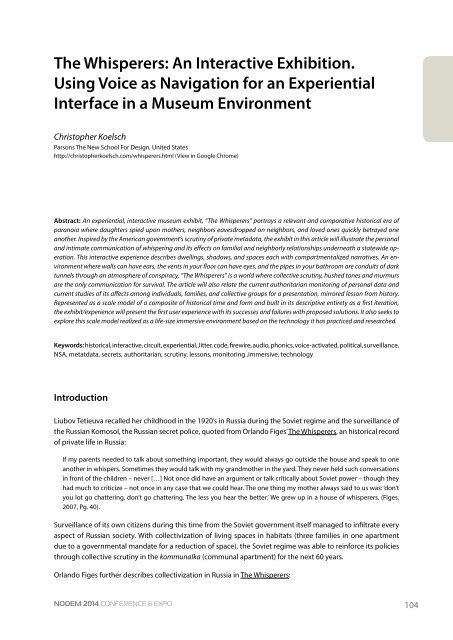NODEM 2014 Proceedings
NODEM 2014 Proceedings
NODEM 2014 Proceedings
You also want an ePaper? Increase the reach of your titles
YUMPU automatically turns print PDFs into web optimized ePapers that Google loves.
The Whisperers: An Interactive Exhibition.<br />
Using Voice as Navigation for an Experiential<br />
Interface in a Museum Environment<br />
Christopher Koelsch<br />
Parsons The New School For Design, United States<br />
http://christopherkoelsch.com/whisperers.html (View in Google Chrome)<br />
Abstract: An experiential, interactive museum exhibit, “The Whisperers” portrays a relevant and comparative historical era of<br />
paranoia where daughters spied upon mothers, neighbors eavesdropped on neighbors, and loved ones quickly betrayed one<br />
another. Inspired by the American government’s scrutiny of private metadata, the exhibit in this article will illustrate the personal<br />
and intimate communication of whispering and its effects on familial and neighborly relationships underneath a statewide operation.<br />
This interactive experience describes dwellings, shadows, and spaces each with compartmentalized narratives. An environment<br />
where walls can have ears, the vents in your floor can have eyes, and the pipes in your bathroom are conduits of dark<br />
tunnels through an atmosphere of conspiracy, “The Whisperers” is a world where collective scrutiny, hushed tones and murmurs<br />
are the only communication for survival. The article will also relate the current authoritarian monitoring of personal data and<br />
current studies of its affects among individuals, families, and collective groups for a presentation, mirrored lesson from history.<br />
Represented as a scale model of a composite of historical time and form and built in its descriptive entirety as a first iteration,<br />
the exhibit/experience will present the first user experience with its successes and failures with proposed solutions. It also seeks to<br />
explore this scale model realized as a life-size immersive environment based on the technology it has practiced and researched.<br />
Keywords: historical, interactive, circuit, experiential, Jitter, code, firewire, audio, phonics, voice-activated, political, surveillance,<br />
NSA, metatdata, secrets, authoritarian, scrutiny, lessons, monitoring ,immersive, technology<br />
Introduction<br />
Liubov Tetieuva recalled her childhood in the 1920’s in Russia during the Soviet regime and the surveillance of<br />
the Russian Komosol, the Russian secret police, quoted from Orlando Figes’ The Whisperers, an historical record<br />
of private life in Russia:<br />
If my parents needed to talk about something important, they would always go outside the house and speak to one<br />
another in whispers. Sometimes they would talk with my grandmother in the yard. They never held such conversations<br />
in front of the children – never […] Not once did have an argument or talk critically about Soviet power – though they<br />
had much to criticize – not once in any case that we could hear. The one thing my mother always said to us was: ‘don’t<br />
you lot go chattering, don’t go chattering. The less you hear the better.‘ We grew up in a house of whisperers. (Figes,<br />
2007, Pg. 40).<br />
Surveillance of its own citizens during this time from the Soviet government itself managed to infiltrate every<br />
aspect of Russian society. With collectivization of living spaces in habitats (three families in one apartment<br />
due to a governmental mandate for a reduction of space), the Soviet regime was able to reinforce its policies<br />
through collective scrutiny in the kommunalka (communal apartment) for the next 60 years.<br />
Orlando Figes further describes collectivization in Russia in The Whisperers:<br />
<strong>NODEM</strong> <strong>2014</strong> Conference & Expo<br />
104


